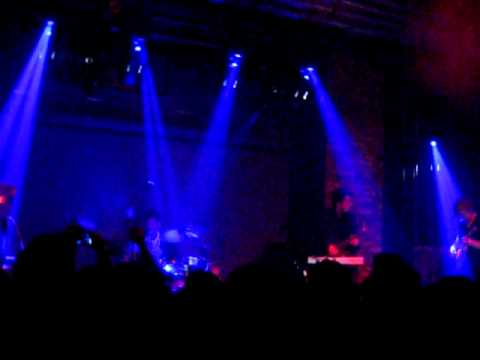Spurned guestlist wannabes, fake competition winners, epic queues – it’s fair to say there’s more than a little hubbub and hyperbole to start this Wednesday evening with Nicolas Jaar. But maybe not so undeserved. There’s an uncharacteristic sense of excitement even among the most po-faced of cool kids flocking into Fabric’s Room One tonight. Whether they’re here to see their "favourite act in the whole world" or just have a good time tonight, this is very much a first-off, showcasing Jaar’s new live incarnation replete with backing band. The question is, will it make us dance?
If you’ve been at all caught up in the recent rise of the Jaar phenomenon, you’ll know that Nicolas is the precociously talented Ivy League progeny of Chilean artist Alfredo Jaar. At only 21-years of age he’s being ascribed such grand, condescending descriptors as prodigy or wunderkind. Something else you may know is that he’s one of a growing number of these wunderkinds who are breaking new ground in dance music through slower tempos, sparser beats and subtler, more deeply layered sounds.
Of course, the concept of slow dance isn’t as much of an oxymoron as it once was. The post-millennial backlash against brashness has been going on at since at least the days of early Kompakt and Border Community – house and techno labels which reacted against the excesses of trance and electro with their luscious minimal sounds. Similarly, dubstep’s rise through the last decade reflects how the elements of slow beats and undulating bass can translate from a quiet underground movement into huge chart appeal. The ‘less is more’ approach has seen The XX receive awards for their icy chill-pop, not to mention the proliferation of chopped-and-screwed hip hop pushing tempos down ever further.
With producers in more commercial circles regressing back to the big build-ups and anthemic extremities of trance, a new generation of artists has created a counter-movement. Plumbing the very depths of dance’s seabed, it’s got to the point where artists like James Blake and Jamie Woon can receive regular radio play with tracks featuring long empty passages of reverb and sub bass. This kind of thing – be it on the radio or even the dancefloor – would’ve been unheard of only a few years ago.
Sometimes I meet people who say they don’t get dance music at all, and in my struggle to convert them I’ve found myself saying something along the lines of: Think of a dance track as though it were a painting. The beat is the frame or border surrounding the tableau. Some frames are just there to prevent the picture from falling off the wall. Others are grand affairs, ornate and inviting, drawin the eye towards the space the picture occupies. The frame isn’t usually what makes an artwork interesting or unique, but it does give the artist that important boundary in which to work; same as the beat in dance music creates a rhythmic structure to be filled with myriad styles, sounds and variations. What matters is how the artist or musician chooses to fill that space.
Okay, the analogy’s kind of trite, and I realise I won’t be converting as many people to the dance movement as inviting angry Richie Hawtin fans to spout abuse all over the Quietus’ comments box. That said, it does serve a handy metaphor when discussing the music of Nicolas Jaar – an artist known not only for dispensing of his proverbial picture frame, but often the canvas to boot.
In his own way, Nicolas Jaar is the quintessence of slow young electronica – the end product of this gentle revolution. Following a string of deep house EPs on the Wolf + Lamb label, not to mention his own Clown & Sunset imprint, it was the release of Jaar’s full length debut back in February that truly piqued critics’ interests. Noticeably sparse, even compared with his earlier work, Space Is Only Noise rarely rises above the 100bpm mark. Traditional tech and house drums hardly feature, unveiling enormous chasmic layers filled with dripping wet piano chords, plucked Spanish guitar, jazzy Ethiopian sax and samples from foreign movies. Going back to that poorly-formed analogy, Jaar isn’t just painting without a frame, but painting in thin air.
With critical praise comes critical backlash. For every listener impressed by Jaar’s restraint and ingenuity comes one who is wary of this apparent distancing from the dancefloor. This is jazz music, art music – the kind of thing you’d hear in a museum or at one of Jaar’s father’s art installations. You may even wonder if it still counts as dance music any more.
Plus, what’s different? What makes Nicolas Jaar more innovative or exciting than any number of electronic artists? Brian Eno, Aphex Twin, The Orb: they were all praised in their time for their own slow electronic music – what’s new? The answer may lie in how the ambient works of these acts were recontextualised as music for chill out rooms, after parties and at home. Even Aphex – very much a child of the underground rave scene before diversifying into a range of styles, ambient included – still ramps up the BPMs when playing out live. Conversely, Blake and Woon may have had some recent success with club-based tunes, but both are more interested in presenting themselves as singer- songwriters than dance legends. Nicolas Jaar also writes ‘proper’ songs. His music also sounds great at home on headphones. But no matter how subtle and elegant it gets, or as slow and sparing the beat, Jaar’s output has always been presented with the main room in mind.
As if to prove that point, Jaar drops his first beat. One beat. And it’s as heavy as fuck. So heavy in fact that a wave ripples across the tightly-packed dancefloor causing the entire room to step involuntarily the left. Before we have times to dust ourselves down it kicks back in – slowly, but determinedly – and as we find ourselves dancing like slow-motion lunatics, we raise the first big cheer of the night.
So why this slow revolution? And why now? The answer is partly technological. The first time I heard dubstep, I heard a sound that sucked all the atmosphere out of the room. Nothing but awkwardly slow undanceable rhythms and intangible basslines that neither moved nor gripped me. The first time I heard dubstep on a proper soundsystem was a different story. Here was a sound where you don’t so much hear the bass as feel it, pinning you by the throat like an invisible hand, and then the stomach, and then the groin. It’s a remarkable feat of audio design when you’re on your way to physically manipulating a human body with simple soundwaves, and some day I fancy we might be able to invent some sort of futuristic disco-space where dancers are propelled into the air by sound – limbs and arms flailing along to bass weight.
But in 2011 there’s no better place to experience Jaar’s music than on a terrific sound system with a vibrating floor. Prior to coming here, I’d been expecting something light and airy – head music if you will. People losing themselves in bliss with arms outstretched as if welcoming some gibbous dance messiah down from the heavens. Nothing could be further from the truth. Much like tonight’s oversubscribed crowd capacity, Jaar’s sound is thick, heavy and remarkably physical. What might have been a gently lulling tone on record has been transformed into a lumbering monster of a bassline. Imperceptible subtleties from the album are now huge earworms played on synth or sometimes live sax. I even hear one guy chanting along to a melody line from Space Is Only Noise as though it were a well-known Madonna lyric.
Meanwhile, on stage, Jaar’s locked in a forward stance, conducting his small ensemble with laptop and various machines. Rather than simply bashing out a house beat along with the music, the drummer should be commended for using his kit as though it were a sampler – triggering syncopated snares and cymbals in counterpoint to Jaar’s pulsating kicks. Similarly, the sax operates for the most part as peppered punctuation to the rhythm, gaining a centre-spot on the jazz-flavoured ‘Keep Me There’. Finally the use of guitar adds a sense of urgency and crunch to some of Jaar’s sparser moments, turning tracks like ‘Too Many Kids Finding Rain In The Dust’ into a tremendous build-it-up anthem.
Just as it feels like Jaar and co are about to rock out, the band slows down to a third of the tempo, rending the second big cheer of the night. It’s as though the slower they play the more crushing and visceral the result. I find myself being strangely reminded of doom metal bands like Electric Wizard and Sunn o))) whose modi operandi are to envelope their audiences with super-decelerated heaviness rather than adrenal attack. A more dance-friendly comparison would again exist in the parallel universe of dubstep, wherein large gaps between beats are exploited for maximum bass response. In his own way Jaar has tapped into that same mindset: slow doesn’t necessarily mean soporific, and energy can be generated from the sheer potency of build.
Jaar picks up the mic and starts to sway as the night climaxes with the double-whammy of ‘Mi Mujer’ and ‘El Bandito’: two Latin-tinged highlights from some of Jaar’s earlier EPs. He’s been standing stock-still for most of the night and while he may be no stranger to playing live sets around the world, one suspects the novelty of playing with a full band to such a responsive crowd might have overwhelmed him. He’s hitting his stride now though, intoning Spanish phrases over flamenco- disco rhythms; traces of a smile breaking through his stoic young brow.
I’m left with one conclusion: it’s not the band that makes tonight unique. It’s not even the fact Jaar plays slow music or quiet music or museum music. It’s the fact he knows how to move a crowd. From whatever devil he may have sold his soul, Jaar has been bestowed an insane amount of talent in return. At only 21, his enhanced technical ability, sonic savvy and unique magic touch have allowed him to straddle the physical and cerebral worlds of both club and home-listening settings without forfeiting one for the other. This is Jaar’s proverbial picture frame. As long as it works on the dancefloor, he may do whatever he feels within it.




